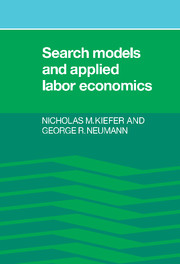Book contents
- Frontmatter
- Contents
- Preface
- 1 Introduction
- Part I Wages, reservation wages, and duration
- Part II Continuous-time models of duration
- Part III Applications
- 8 Structural and reduced form approaches to analyzing unemployment durations
- 9 Wages and the structure of unemployment rates
- 10 How long is a spell of unemployment? Illusions and biases in the use of CPS data
- Part IV Mobility and contracting
- Index
9 - Wages and the structure of unemployment rates
Published online by Cambridge University Press: 06 October 2009
- Frontmatter
- Contents
- Preface
- 1 Introduction
- Part I Wages, reservation wages, and duration
- Part II Continuous-time models of duration
- Part III Applications
- 8 Structural and reduced form approaches to analyzing unemployment durations
- 9 Wages and the structure of unemployment rates
- 10 How long is a spell of unemployment? Illusions and biases in the use of CPS data
- Part IV Mobility and contracting
- Index
Summary
The labor market consequences of macroeconomic policy during the past decade present an uncomfortable prospect for the future. Unemployment during the seventies averaged 6 percent of the labor force, reaching a quarterly high of 8.8 percent in 1975. Among some groups, the results were even worse: teenage unemployment averaged over 16 percent for the decade. Inflation, measured by movement in the consumer price index (CPI), averaged over 7 percent and was 11.5 percent in 1979. Consumers and workers face the unpleasant prospect of having to continue to cope with rates of unemployment and inflation well in excess of those considered normal a decade ago.
One “reason” for this bleak state of affairs is that the rate of unemployment consistent with any particular level of inflation has shifted. As Perry has noted, the labor force is increasingly female and young; these groups have historically had high unemployment rates. The growing numbers of these groups, even coupled with their high unemployment rates, appears to have little effect on the rate of wage inflation. This combination of high unemployment rates and little or no reduction in inflation presents a dilemma that appears to be unsolvable by conventional fiscal and monetary policies. However, as Baily and Tobin have noted, selective programs of job creation or wage subsidies can reduce the measured level of unemployment attendant to any rate of inflation by reducing the slope of the inflation–unemployment trade-off in the short run and the natural rate of unemployment in the long run.
- Type
- Chapter
- Information
- Search Models and Applied Labor Economics , pp. 179 - 202Publisher: Cambridge University PressPrint publication year: 1989

